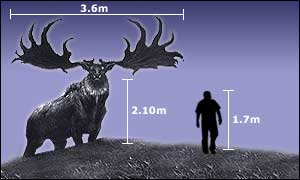
Basic List of all Archaeological Sites |
|
| Site Name | Description |
| Ballyoran Bog | Excerpt from the report Archaeological Excavation Report 04 E1014 ext. Ballyoran Bog "The Giant Irish Deer from Ballyoran Bog were found in clays below the peat and all dated examples of Giant Irish Deer from similar find-spots have returned radiocarbon dates indicate that populations lived in Ireland in the period between 11,750 BP and 10,950 BP (Woodman et al. 1997). The radiocarbon dating of Giant Irish Deer antler from Ballyoran Bog returned a date of cal BC 11139-10962 (UB- 6777). This predates the earliest evidence for human occupation of the Irish landscape (Mesolithic, c.7500-4500 BC)." "The identification of the wood samples from the platform/trackway suggested that alder and willow/ poplar timbers were the main wood types in use (Johnston 2006). These trees generally grow in damp places and can tolerate intermittent waterlogging. It is therefore likely that the wood from this structure was sourced on the bog or near its edge before felling and it was perhaps not specially selected but was used when necessary. A radiocarbon date of cal BC 8280-7965 (UB-6780) was returned from Layer 3. The date is problematic because it predates all known human activity in the area. It is possible that old wood, preserved in the bog, was used in the construction of the trackway, and this is why the date returned was so early. A second piece of timber, from Layer 2, was sent for radiocarbon dating in the hope of clarifying the actual date of use at the site. A Late Neolithic radiocarbon date of cal BC 3012-2761 (UB-6970) was returned. This is also an extremely early date for construction of a trackway within peatlands and begs the question of whether the site was naturally formed. However, the chop mark on the Giant Irish Deer antler fragment retrieved from the site is a positive indication of human activity." "Conclusion Eachtra Archaeological Projects were engaged to monitor works within previously untested or unresolved locations along the route of the new N8 Rathcormac/Fermoy Bypass, between June 2004 and February 2005. Three previously unknown archaeological sites were discovered in the course of monitoring internal works. One such site was at Ballyoran Bog, where remains of Giant Irish Deer and a possible brushwood trackway were excavated. The skeletal remains of the Giant Irish Deer are a rare occurrence on archaeological sites, but one of the most interesting aspects of the excavation was the discovery that later inhabitants of the area were aware that deer remains were present in the bog, as tool marks on antler fragments demonstrate. Excavation and post-excavation analysis of the brushwood platform/trackway has revealed that the occupiers of this site exploited the immediate environs of the bog for construction materials. The discovery of the possible trackway is significant, given that the majority of those sites recorded in Ireland are located in the Midlands. In conclusion, the site at Ballyoran bog is important on a provincial, as well as a national scale."
Listen to Seamus Heaney's "Bogland"
|
| Gortore 1B | A section from the Archaeological Report - Gortore 1 b, Co. Cork (Ireland) "The site at Gortore 1b was located on the southern bank of the River Funshion. The northern edge of the area of excavation came within c. 25 m of the edge of the modern course of the river. The ground sloped from the south to the river while on the northern bank of the river the land was level and was prone to flooding. Area 3 in particular due to The southern bank of the Funshion Fiver was occupied intermittently in the Mesolithic Period and may have been occupied through out the Neolithic period. The archaeology recorded in Gortore E2119, on the route of the N8 Rathcormac to Fermoy, was located to the east of Areas 1, 2 and 3 in Gortore 1b, on the route of the N8 Fermoy to Mitchelstown. It is quite likely that further archaeology is preserved in situ in the vicinity of the two sites. Mesolithic Early Mesolithic Period Late Mesolithic Period |
